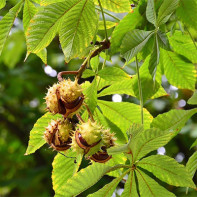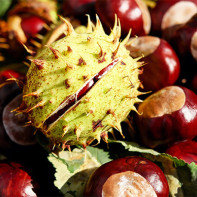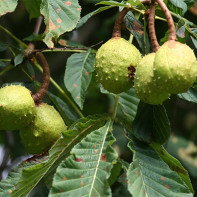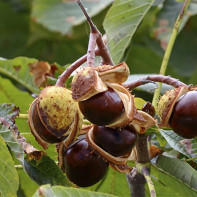Horse chestnut: medicinal properties and contraindications
Horse chestnut is used to treat a range of diverse diseases. It has long been appreciated in both official and traditional medicine. The plant is part of the medicinal products, in addition, its widespread use at home is noted. This article will examine the properties of horse chestnut fruits and their effect on the human body. In addition, here you can find recipes for independent use.
- Chemical composition
- How it looks and where it grows
- Etymology of the name
- Distribution area
- Collection and storage
- How to distinguish horse chestnut from edible
- Composition
- External features
- The healing properties of horse chestnut
- For women
- For men
- During pregnancy
- When losing weight
- Horse chestnut in folk medicine
- With diabetes
- With hemorrhoids
- With varicose veins
- With prostatitis
- With sinusitis
- With thrombophlebitis
- With hypertension
- With atherosclerosis
- Types of healing compounds
- Infusion
- Tincture
- Decoction
- Tea
- Ointment
- Cream
- Butter
- Inflorescence juice
- Solution
- Application in cosmetology
- Is it possible to eat horse chestnut
- Contraindications and side effects
Chemical composition
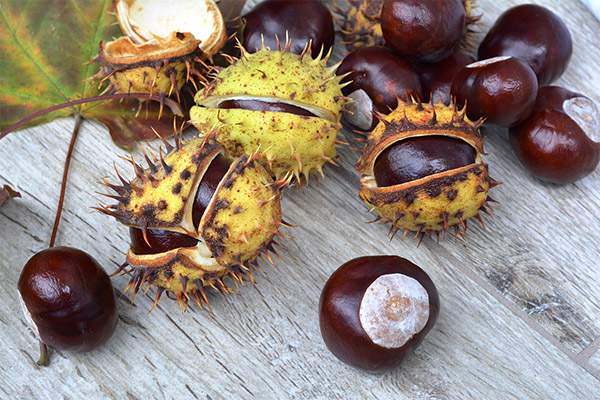
- In all the constituent parts of the plant there are beneficial substances. So, the flowers contain a large number of flavonoic glycosides: rutin, kempfer glycoside, quercetrin. Plus, they are rich in adenine, guanine, adenosine, choline, sugars and acids.
- Saponins (escin), oxycoumarins (fraxin, esculin), flavonoids, sterols, starch, essential oils, protein, tannins and other organic mineral impurities were found in chestnut seeds.
- Leaves contain flavonoids: spireoside, rutin, quercetin and carotenoids: lutein, violaxanthin.
- Vitamins A, B, and C were found in the tree bark; therefore, it can be used as an immunostimulating and antipyretic agent.
How it looks and where it grows
Perennial is a tall, large tree (up to 30 m), belongs to the Sapindaceae family. The crown is thick and spreading, the trunk is wide, dark gray.
At the time of flowering, the tree is covered with white or pale pink elongated inflorescences (10-15 cm), which include up to 30 small flowers. It begins in early May - late June, a short one.
The leaves of the chestnut are folded, up to 25-30 cm long, petioles up to 25 cm in size. They are rough and wrinkled, pointed at the end, wedge-shaped. Streaks appear on the reverse side. Color - dark green, sometimes it can give a red tint. They have a pleasant faint smell and astringent taste.
The fruits of the chestnut are spherical with three wings. The diameter of the seed box can be up to 6 cm, a characteristic light green color. Inside there is usually one large seed. It is smooth and shiny, flattened on the sides, covered with a brown shell, tastes bitter. The fruits ripen in early autumn.
Etymology of the name
This is due to the fact that there are more than 20 varieties of chestnut. The name was coined in order to distinguish the subspecies from those used in food. In addition, they are used as animal feed. And so you can find the second name - horse chestnut.
Some literature indicates that the name appeared due to the fact that scars similar to a horseshoe were seen on the shoots of the plant. It has strengthened and has survived to the present day.
Distribution area
For the first time a plant was found in Northern Greece, because it is considered to be its homeland. Now it is distributed in southern, eastern and central Europe. It is also found in China, Japan and the United States.
In Russia, it can be found in the Arkhangelsk region, Khabarovsk Territory or Primorye. But horse chestnut grows here no higher than 2 m and looks like a bush.It adapts well to cold and other unfavorable conditions, therefore it has taken root in the northern regions of the country, it blooms successfully and gives fruit. It is also found in the central regions, but it is a tree.
Due to its unpretentiousness and brightness of appearance, it is often used as an ornamental plant, so it can be found in city parks, alleys or gardens. It allows you to create beautiful, elegant landscape compositions.
Collection and storage
As mentioned above, healing components were found in all parts of horse chestnut (leaves, fruits, branches, bark and flowers).
Harvesting begins during the flowering period (May – June), this is a good time to collect branches and bark, here you can collect leaf cover. They leave fruit until the fall. They can be found under the trees or torn from the branches.
The material is dried outdoors, avoiding direct sunlight. For this, a well-ventilated indoor room is well suited. The air temperature must not exceed 25 ° C, which must be taken into account when using an electric dryer.
Raw materials can be stored for 1 year in a dry place, avoiding moisture. Special paper or fabric bags can help.
How to distinguish horse chestnut from edible
The Sapinda family includes several varieties of horse chestnut: yellow, ordinary, forest, red and Japanese. If it is not so difficult to distinguish them from each other, then it is simply necessary to identify differences with edible subspecies.
The botanical description gives the concept that horse and edible chestnuts are different subspecies. Therefore, it is important to understand how they differ.
Composition
Horse chestnut contains a small amount of protein and other substances of nutritional value. However, its constituent components have healing properties, which allows it to be used as a raw material for medicines. In addition, edible chestnut belongs to another genus of shrubs.
Important: horse chestnut is not eatable! You can determine it by a bitter aftertaste.
External features
There are several distinctive features for the eye. This can also be understood by comparing the botanical description, we will analyze the features in more detail:
- Tree height. The length of the horse chestnut trunk reaches 25-30 m (but dwarf breeds are also found - up to 10 m). Edible representatives are much higher and can be up to 50 m.
- The deciduous cover of trees with edible fruits consists of oval leaves. The plate is 20–25 cm long, 7 cm wide, and the leaves are located on short petioles.
- Flowering period. The flowers of horse chestnut are bell-shaped, up to 2 cm in size, collected in pyramidal inflorescences. Edible representatives bloom spike-like. In addition, their flowering begins later - in the middle of summer.
- Fruit. The walnut chestnut shell crack during ripening, and you can clearly see that it stores only one seed. Eatable chestnuts produce 1 to 3 flattened nuts.
- A significant difference is also the seed box cover. At horse chestnut, it is light green and has short spikes. The fruits of the edible chestnut are covered with a brown acicular membrane.
The healing properties of horse chestnut
The high content of components useful for the human body determines the widespread use of chestnut in pharmacology. It is used as a venoprotective, venotonic, anti-inflammatory, antiseptic and antimicrobial agent. In addition, it helps to improve circulation and thinning of venous and arterial blood, it is used as a stimulator of tissue growth and a wound healing substance.
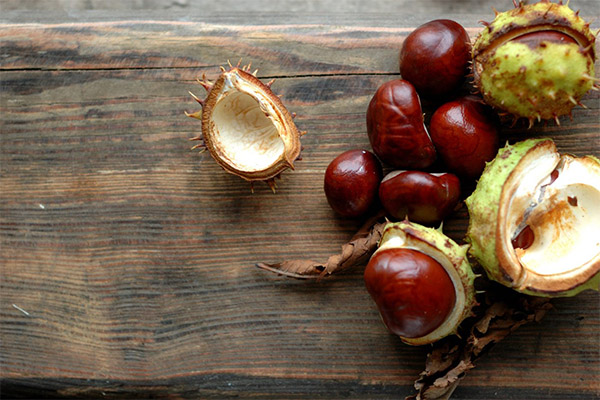
Horse chestnut is also valued for being able to provide assistance in the following cases:
- volumetric venous blood supply;
- pathology of the heart and vascular system;
- open wounds on the surface of the body;
- the need for pain relief;
- increased swelling;
- disorder of the nervous system;
- problems with the stomach and intestines;
- the occurrence of convulsive and spasmodic syndrome.
Pharmacy preparations
- Drops Aescusan. They help fight stasis in the legs, the initial stage of varicose veins, ulcerative formations and intestinal hemorrhoids. Effective in the fight against thrombosis and inflammatory processes. Method of application according to the instructions: 15–20 drops 3 times a day.
- Chestnut tincture. Helps support the body and prevents heart attacks, strokes and heart attacks. Moreover, it alleviates the symptoms of hemorrhoids and prostatitis.
- Extract. The extract from the plant is rich in escin. Helps in the fight against hypertension (normalizes blood pressure), edema, elevated cholesterol plaques, as well as thrombosis and varicose veins.
- Tablets. They are an analogue of the drip system, easy to use and help to comply with the norm. The dosage is set by the attending physician due to the individuality of each organism. Usually, the dose is increased gradually - from 1-2 capsules to 3-4 per day.
In addition to the listed above, horse chestnut medicines have a positive effect in the following diseases:
- disturbances in the work of the gallbladder;
- pathology of the spleen (leukemia, malaria, lymphogranulomatosis);
- swelling in the kidneys and heart;
- arthritis, arthrosis, hernial neoplasms;
- osteochondrosis, sciatica, sciatica;
- problems with the excretory system;
- pulmonary diseases (whooping cough, bronchitis, tubercle bacillus, pleurisy);
- anemia;
- oncological tumors and radiation.
For women
The tonic effect that the plant has has provided for widespread use in cosmetology.
Washing with an extract favorably affects the health of the skin, increases its elasticity, and helps to get rid of acne, black spots and the effects of acne. Plus, it is possible to sanitize the skin and save them from pollution. Rinsing will stimulate cell nutrition and reduce tissue edema.
Horse chestnut ointments, provided they are used continuously for a long time, help in the regeneration process, give a lifting effect, smooth wrinkles and scars. We can conclude that chestnut has anti-aging properties, which are achieved through the renewal of the dermis.
Among other things, oil wrapping increases the overall tone of the skin, reduces the fat layer and normalizes blood flow.
For men
As mentioned above, the plant has a positive effect in the treatment of prostatitis, prostate adenoma and problems with potency. Most often, such diseases appear in middle-aged men - over 40 years old, but they also occur in younger ones.
With prostatitis, the excretory system primarily suffers. Chestnut has an effect on reducing tissue inflammation, expanding the urethra, and normalizing blood outflow. Inflammation is blocked, the frequency of going to the toilet decreases, pain disappears. The prostate also comes in order.
Getting rid of blood stasis and slowed blood circulation, stimulating blood flow to the genitals activates the movement of lymph, removes toxins from the body and relieves the man from problems with potency.
Important! Before use, consult with a specialist. Abnormal reception can lead to negative consequences.
During pregnancy
The high content of vitamins, minerals, fiber and carbohydrates allows the use of chestnuts during pregnancy. However, this is possible only in the case of the correct preparation of the compositions and in a strictly limited quantity.
They cope well with any viral infection, therefore, during pregnancy it is useful to use a cold-proof infusion. In addition, you can prepare a decoction against whooping cough or from kidney failure, problems with the stomach and intestines. The basis of such solutions must include not only the leaves, but also the bark, branches and flowers.
In addition, during pregnancy, wounds and ulcers can be treated.In addition to the disinfecting effect, chestnut will contribute to the rapid healing and regeneration of the skin. Plus, it has antimicrobial and antipyretic effects, so it will do without unnecessary antibiotics.
When losing weight
The plant contributes to the removal of toxins from the body and the rapid breakdown of the fat layer, therefore it is often used by those who want to lose weight. It speeds up the metabolism and restores the water balance in the body.
You can use both tinctures and decoctions, and wrap. The use of a scrub from chestnut bark will not be superfluous, however, it must be used with caution and first applied to a small area of the skin to detect a reaction (it can cause irritation).
People with extra pounds often suffer from leg swelling. A decoction of chestnut will help to remove excess fluid and improve the functioning of the excretory system, so the weight will go away more rapidly.
Horse chestnut in folk medicine
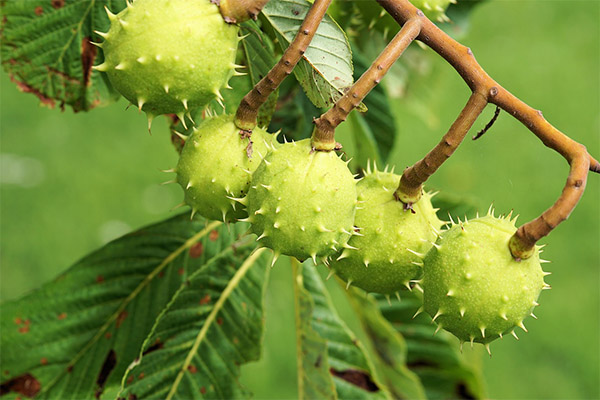
The use of horse chestnut is not limited to pharmacology. A wide range of its use at home according to recipes of traditional medicine. With its help, you can independently fight:
- with increased blood coagulability;
- diabetes mellitus;
- vascular diseases and heart failure;
- thrombosis
- high levels of cholesterol in the blood;
- digestive system disorders.
In addition, chestnut at home use eliminates edema, varicose veins, hemorrhoids, thrombophlebitis and sinusitis. Consider these diseases in more detail.
With diabetes
Diabetes mellitus is a fairly common disease. There are many reasons for the increase in blood sugar. Few people know, but horse chestnut has a positive effect on the course of the disease and even relieves its symptoms. This is manifested in the following:
- restoration of vascular wall elasticity;
- lowering blood sugar and cholesterol plaques in the blood;
- improvement of metabolic processes of the body;
- normalization of blood condition.
Diabetics are advised to take chestnuts in this way: boil a teaspoon of leaves in a glass of boiling water for 20 minutes. Allow the liquid to cool and infuse for about half an hour, and then strain. With this decoction, wash the wounds and affected areas.
In case of diabetes of the second degree, the workpiece is subjected to a different effect: pour 100 g of tree bark with 1 liter of vodka. The liquid is infused in a dark place for 14 days. Dosage: 10 drops 3 times a day before meals.
Attention: do not be afraid of a large amount of sugars in the composition. They are absolutely harmless, since they do not affect the process of insulin synthesis. On the contrary, they have a beneficial effect on the work of the pancreas.
With hemorrhoids
A healing broth from hemorrhoidal inflammation can be prepared as follows: boil 3 tablespoons of tree bark in 1 liter of water for 15–20 minutes. The infusion of the decoction is 8-10 hours (you can leave it overnight). Strained fluid used as compresses and sitz baths. Repeat the procedure after each bowel movement.
Another working option is microclysters. They are prepared as follows: Pour 1 tablespoon of crushed dry bark into a glass of boiled water. Cover it with a towel to maintain heat and leave for 3 hours. Filter the cooled drug, after which it becomes suitable for an enema (30-50 ml).
Drops from fresh chestnut juice are taken orally up to 30 drops before each meal (3 times a day). This helps strengthen blood vessels and eliminate inflammation.
You can take baths with herbal pharmacy fees, which include chestnut. Such a mixture is not difficult to prepare at home, you will need: horse chestnut fruit peel (3 parts), dried chamomile (3), sage (2), oak bark (5). 2-3 tablespoons of the mass pour 1 liter of boiling water and cook over high heat. Leave the broth overnight (the time for insisting is 12-14 hours). Baths take no longer than 15 minutes. The treatment course includes 10 baths with an interval of 2-3 days (that is, the duration of therapy is 1 month).
With varicose veins
The overwhelming majority of the population suffers from this disease, mainly women. It manifests itself not only with age, it can be provoked by weight lifting, a stable position in work - sitting or standing, uncomfortable shoes. Varicose veins, unfortunately, are very difficult to treat. Horse chestnut comes to the aid in the fight against the disease, it is able to alleviate the symptoms until its complete elimination. The plant is able not only to prevent the appearance of varicose veins, but also to suspend it.
Recipe: pour the chestnut tree bark with 1 liter of vodka. The mixture is infused for 14 days. To use twice a day (in the morning and in the evening), inside on 15–20 drops. The positive effect will be noticeable after 2-3 months of admission.
Attention: you need to ensure that the time between the first and second use is not less than 12 hours.
In addition, varicose veins can be cured by applying pharmacy creams and ointments, which include horse chestnut.
With prostatitis
The anti-inflammatory and antibacterial effects of the plant have a beneficial effect on the functioning of the human prostate gland. The pain will disappear, the excretory system will begin to function normally, the sensation of constriction of the bladder will pass, and the number of trips to the toilet will decrease dramatically. Erectile function will also be restored.
For treatment, it is necessary to have a shell of a chest seed box and a walnut shell. They will be the main ingredients for tincture. They are dried and crushed, after which they will be ready for further action: 1 tablespoon of the mixture is poured into 100 ml of pure alcohol. The liquid is closed with a lid and cleaned in a dark place where it is located for 14 days. After 2 weeks, it is filtered. The resulting tincture is ready for use: take it 10 drops 2 times a day before meals (for 10 days).
A positive effect is manifested by eliminating the swelling of the human excretory system, which is due to the components that make up the plant.
With sinusitis
For the treatment of sinusitis, as a rule, it is advised to use unripe fruits. Due to the possible absence thereof, ripe frozen nuts are allowed. They are poured with boiling water and left for several hours. After that, the core is peeled and cut into small bars - turunds. They are inserted into the nasal passages, where they contribute to the discharge of purulent stagnation.
Attention: this method can cause severe itching in the nasal cavity and sneezing. Turundas are made for 5-7 days, every day using new chestnut candles. They help to quickly get rid of the disease, as they have a pronounced effect.
Washing the nose with chestnut tincture also helps to cleanse the pus from the sinuses. To do this, repeat the above steps (before cutting into small cubes) and rub the fruit on a grater. The mass is poured with warm water and insisted for about a day. Twice a day, the nasal cavity is washed for one week. Tincture can serve as a prophylactic.
The method of inhalation with the addition of essential fatty oils of chestnut is very popular. To do this, breathe over hot water with oil for about 10-15 minutes. It can be done within 10-12 days.
Attention: inhalations are allowed only in the absence of large accumulations of pus and high body temperature. This method allows you to improve mucus discharge and acts as an anti-inflammatory event. In addition, you can do cold inhalation.
A mixture of vegetable oil and grated horse chestnut seed is used to massage the sinuses (1-2 times for up to 10 minutes).
With thrombophlebitis
A loyal enemy of this disease is chestnut. Together with other pharmacy herbs, you can achieve a faster effect, but in the absence of such an opportunity, he can cope on his own.
During the course of thrombophlebitis, some features of the blanks must be taken into account:
- Flowers and leaves, subsequently included in the mixture, should be picked in the spring (flowering start period), then they will contain a greater number of useful components.
- Harvesting fruits and bark is carried out later - in late autumn.
- For the infusion, all the components of the plant are suitable.
Recipe for tincture: 2 tablespoons of chopped fruit pour 0.5 liters of vodka. The liquid is insisted for 10-12 days, after which they take 5-10 drops 4 times a day.
Preparation of compresses: grated fruits are combined with an alcohol solution in a 1: 3 ratio or 50 ml of chestnut tree oil is combined with 1 liter of warm boiled water. Both options are suitable for treatment. Gauze is moistened in the infusion and put it on the affected areas of the body. On top of the fabric is wrapped with a film to preserve heat.
Dried bark of the tree is crushed, take 1 teaspoon and pour in glasses of water. The boiled composition is insisted for about an hour. Drink 100-150 ml after eating 2 times a day. The duration of therapy is 1 month.
Rubbing and ointment also have a quick healing effect. To do this, add nuts to the alcohol (in a proportion of 1:10) and leave for 20 days. The resulting infusion is rubbed into the skin until the desired result is achieved.
With hypertension
An extract from the tree bark is rich in escin and saponins. They help in getting rid of edema of the body, varicose veins, improve the state of the capillary system, increase the tone of the veins. Tincture from the bark and fruits helps to eliminate the symptoms of hypertension and arteriosclerosis.
The fastest positive effect can be seen when using an infusion of brown fruit skins: 50 g of peel is poured with 0.5 l of vodka. The liquid is infused (mixed and filtered) for two weeks. This composition allows you to fight growths on the arterial walls, anesthetizes the processes taking place with the participation of veins, removes edema and dilates vascular patency.
At the beginning of the complex of procedures (1 week), 25 drops are mixed with 2 tablespoons of water and drunk 3 times a day. Then, for another 4 weeks, the number of times is increased to 4.
A decoction of bark and flowers is also able to have a beneficial effect on the disease: 1 teaspoon of bark and 1 teaspoon of petals are ground and poured with a glass of boiling water. The composition is boiled for 30 minutes over low heat. Method of administration: the first 2 days are consumed in a pair of teaspoons once a day. Then the number of receptions is increased to 3.
With atherosclerosis
Traditional medicine has long used flowers, fruits, and the sheath to treat this disease. They are subject to processing and are part of creams, compresses, lotions, decoctions and infusions. This is due to the presence of escin and triterpensaponin, which, in turn, contribute to:
- strengthening and increasing the elasticity of the vascular walls;
- blood thinning;
- removal of edema;
- lowering blood pressure;
- anesthesia of the limbs.
Suitable for use in the initial stages of the disease, but the doctor should prescribe therapy, since there is a spectrum of contraindications.
Tincture on vodka allows you to get rid of cholesterol plaques and promotes the expansion of blood vessels. 5 chestnut fruits pour 100 ml of vodka (half a glass). Insist for two weeks, after which they take 3-15 times a day for 10-15 drops, diluting in a teaspoon of water. The duration of treatment is 10 days.
The second effective remedy is a decoction of fruits. 2 nuts are poured with a glass of clean water and boiled for about 30 minutes. Take 1 tablespoon in the first 3 days, and then double the amount and drink another 7 days. Thus, the course length is 10 days.
An infusion based ointment is just as effective. To do this, the prepared tincture is mixed with the usual lanolin cream and rubbed into the legs before bedtime.
Types of healing compounds
For the preparation of medicinal compounds in traditional medicine, all the components of the plant are used. Each of them contains a large concentration of substances that have a healing effect on the body. In this regard, the following therapeutic forms are made: decoctions, infusions, ointments, juice, tea, creams and oil. Let's consider some of them in more detail.
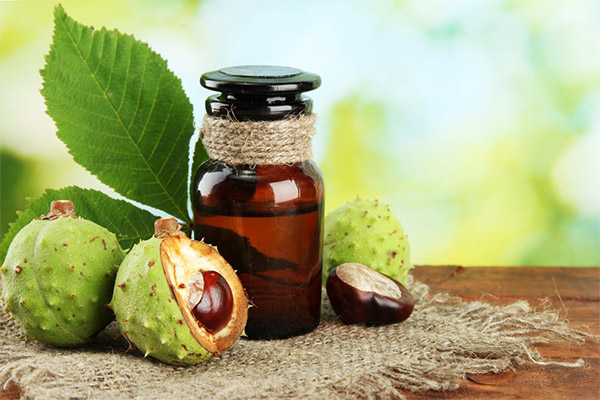
Infusion
The components of infusions can be all parts of the tree (from the stem bark to seed bolls), they are poured with cold or boiled water, depending on the recipe. The infusion is cooled and left for a while, then decanted and take 2-3 tablespoons daily (depending on indications).
Such drugs help in the treatment of liver and kidney failure, disorders in the gallbladder, inflammations of various properties. In addition, they can become the basis for compresses, lotions and dressings.
Tincture
Tincture is prepared by pouring the components with alcohol or vodka and insisting in a cool dark place for 10-14 days. Suitable for this are leaves, fruits, peel of the seed box, stem bark.
An example of a recipe: 3 tablespoons of dried shell pour 0.5 liters of alcohol and leave to simmer for 14 days. After the tincture is ready, it is applied to the disturbing joints or rubbed on the skin.
The following example: pre-chopped chestnut kernels (50 g) are placed in 250 ml of vodka. Leave in the refrigerator for 14 days (note: shake the jar daily). Strained finished liquid is consumed for one month, 15–20 drops three times a day. It helps a lot in the treatment of dilated veins and arteriosclerosis.
Recipe: grains with peel are crushed in a meat grinder and put into a glass bowl. The mass of the mixture is 300 g. It is poured with 1 liter of vodka and insisted for a week. It helps get rid of the symptoms of radiculitis, thrombophlebitis, seizures and inflammation of muscle tissue.
Decoction
Most often, a decoction is made from bark and petals. Raw materials, flooded with water, boil for about half an hour, after which they are decanted and diluted with a warm, clean liquid. Take a decoction of 1 tablespoon per day, gradually increasing to 100 ml at a time.
It helps with disorders in the functioning of the stomach and intestines, failures in the digestive system, has a painkiller and anti-inflammatory effect, therefore it is often prescribed for gynecological inflammation and in urology. A decoction can become the basis for rinsing the mouth with diseases of the gums and teeth, stomatitis and fluxes.
Recipe: 1 teaspoon of bark is soaked in warm water (2 cups or 400 ml). Day insist in a dark place at room temperature. Drink 200 ml per day. The tool helps in the treatment of neuralgic pathologies, emotional instability and loss of strength.
Tea
The drink is brewed twice a day with meals. Available at the pharmacy separately or in herbal preparations. His taste is neutral, without pronounced bitterness. The main thing in use is consistency. The course is from 3 to 4 weeks.
You can also do it yourself: 1 teaspoon of leaves and flowers pour a glass of boiling water. You can add ginger or honey if desired. Tea well restores strength, normal functioning of the kidneys and liver, strengthens the immune system.
Ointment
External use is no less effective, so chestnut can often be found in the components of ointments and creams. They are prepared on the basis of nuts or petals, the fact is that it is there that the most concentrated fatty oils.
5 chestnuts and 5 tablespoons of inflorescences are crushed and mixed for structuring with vegetable (and best of all with olive) oil, the dosage is 0.5 liters. The mass is beaten to a homogeneous consistency and boiled in a water bath. Apply as decongestant, tonic and sedative.
Cream
The cream perfectly helps to regenerate and tone the skin thanks to the lymphatic drainage property. In addition, he fights varicose veins and diseases of the joints and bones.
You can cook it at home, taking as a basis a fatty substance: sour cream, cream or olive oil (you can use esters if desired). These components are mixed with chopped chestnut and stored in the refrigerator for several months.
Butter
The product is made at home by hand press, and then filtered from impurities. Horse chestnut oil is filled with useful acids, antioxidants, vitamins A, B, C, glucose and flavonoids, so it is very valuable.
Inflorescence juice
Fresh flowers are minced in a meat grinder. Of the resulting mass, gauze is squeezed out all the liquid.Drink juice in 1 tablespoon after each meal (no more than 3 times a day). It is rich in volatile and glycosides.
Juice is good for hemorrhoidal inflammation and varicose veins, plus it has an analgesic effect, so it can be taken with menstrual pain or joint problems.
Solution
The preparation process is very similar to the manufacture of tinctures: crushed fruits are poured with vodka (in the proportion of 1 glass per 1 liter). The drug is left for 2 weeks, and then filtered. This form of rubbing joints and disturbing venous networks. It is also suitable for internal use, provided that it is diluted with water 1: 1.
Application in cosmetology
Chestnut is widely used in the manufacture of cosmetics. Below we will give the main spectrum of forms in which horse chestnut extract is found and their effect on the human body.
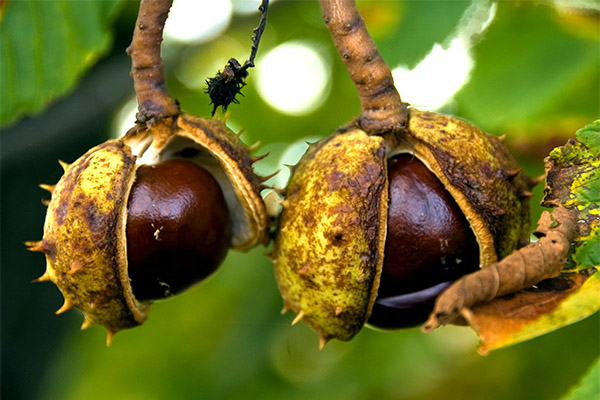
- Helium shampoos for feet. Help in the fight against fatigue, heaviness and swelling.
- Face cream with anti-aging effect. Establishes the outflow of blood and metabolic processes in the cells.
- Creams for the skin around the eyes. They remove bags and dark circles under the eyes, nourish the skin and hide wrinkles, increase the general appearance and elasticity of the skin.
- Anticuperoids. Reduce redness and narrow capillary nets.
- Anti-cellulite complexes. Contribute to the outflow of fluid from soft tissues and adjust the appearance of the skin.
Horse chestnut for hair and skin
A separate point can be identified the effect of horse chestnut on the hair follicles and skin. It is often found as an integral component of gels, shampoos and skin scrubs. Masks and shampoos make hair beautiful, strong and shiny, protect against brittleness and loss. The scalp loses excess fat, is filled with the necessary moisture and gets rid of dandruff. Chestnut nourishes the skin and hair follicles, fills them with vitamins, and also tightens pores.
So, when caring for hair, the plant improves blood circulation of the scalp, compensates for the lack of moisture, strengthens the bulbs, thereby preventing loss. External indicators of hair improve: a healthy glow appears, growth accelerates, inflammations and dandruff disappear.
In skin care products promote microcirculation of the skin, eliminate inflammation, improve complexion and help get rid of edema. They provoke cell regeneration, due to which the wounds heal and small wrinkles are eliminated. The elasticity of the skin and their elasticity noticeably increase.
Is it possible to eat horse chestnut
Let us dwell on this issue once again. Eating roasted chestnuts for food is quite popular, because many of us have been thinking about how to cook them ourselves. But do not rush into this.
Important! The fruits of horse chestnut are absolutely unsuitable for food, they have a bitter taste and can be harmful due to the toxic substances that make up the composition. The use of nuts is unsafe and can lead to food poisoning and even irreversible consequences, even death.
How to distinguish edible varieties from poisonous, it was described above, we fix the main points:
- Horse chestnut has one inshell nut, it is large in size, its shell is light green in color, with many short spikes.
- Edible chestnut can have from 1 to 3 nuts, in addition, they are much smaller than horse. The shell is covered with long burgundy needles.
Contraindications and side effects
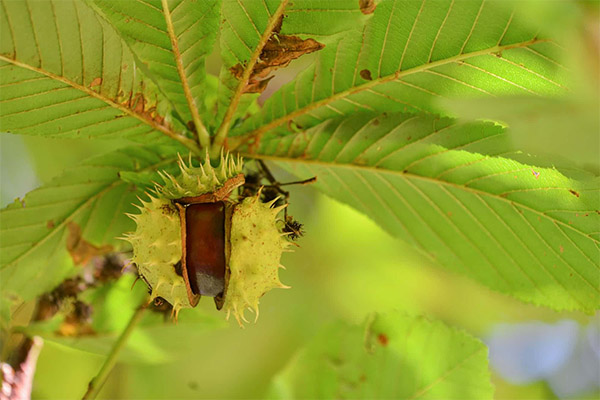
Unfortunately, like all drugs, medicinal formulations from this plant have a number of contraindications, and therefore you can not take them, in case of:
- poor blood clotting;
- ulcerative formations in the stomach and duodenum;
- gastritis with low acidity;
- individual intolerance and the presence of allergic reactions.
Chestnut can disrupt the gastrointestinal tract, as it acts as a means that can cause constipation. Therefore, it is good to use it for diarrhea, but with the opposite problem, this is not worth it.
Plus, it is forbidden to use alcohol-based tincture:
- with chronic exacerbated gastritis or colitis;
- renal and liver failure;
- high degree of hypertension.
Pregnant and lactating women are also contraindicated in the use of tinctures, but they can use ointments, creams and decoctions.
«Important: all information on the site is provided exclusively in fact-finding purposes. Before applying any recommendations, consult with a profile specialist. Neither the editors nor the authors are liable for any possible harm caused materials. "

